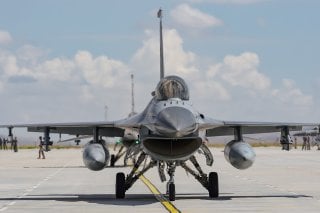Ukraine Wants to Rush F-16 Training, But the Hurdles Are Real
Aviation experts have warned that training on the F-16 can't be rushed, and even experienced pilots trained on Soviet legacy aircraft could face a steep learning curve on the American fighter.
Ukraine is set to receive as many as ninety American-made F-16 Fighting Falcon multirole combat aircraft—while around two dozen of the fighters are now in service. Yet, even as more aircraft could arrive in the coming weeks, the Ukrainian Air Force may lack the pilots to fly the warbirds into action.
Last week, Ukraine's Ministry of Defense announced a bold plan to address the issue. Namely that it would cut the training time.
"The basic training program needs to be optimized. This will enable us to train more pilots to defend our country," Deputy Defence Minister Serhiy Melnkyk said in a briefing last week. "Ukrainian combat aviation must eventually gain air superiority, as this paves the way for the success of our actions on the front line."
Aviation experts have warned that training on the F-16 can't be rushed, and even experienced pilots trained on Soviet legacy aircraft could face a steep learning curve on the American fighter. Then there is the language barrier.
"One major concern from the very start has been the language barrier among Ukrainian candidates, many who have struggled to reach an adequate level of English proficiency to allow them to fully absorb the details of the complex systems of this fourth-generation fighter aircraft," the Kyiv Post reported. It added that "inexperienced pilots may struggle to adequately perform in high-pressure situations that could increase the risk of accidents and mission failure."
Just weeks after the F-16 entered service with the Ukrainian military in early August, Ukraine also lost its first Fighting Falcon reportedly due to pilot error.
Understanding the Training Needed to Fly the F-16
Colonel Alex Mahon, United States Air Force (ret.), a fighter pilot with decades of instructor pilot (IP) experience, offered insight into the basics of F-16 training.
"The core training is done in the 'Conversion Phase,' learning how the basic systems work: engine, hydraulics, electronics, etc.; takeoff; landing; acrobatics; taking the airframe to its inner and outer limits of flyability; instrument flying; getting the 'feel' of the aircraft so you can hear it when it talks to you," Mahon explained in an email to The National Interest.
"Notwithstanding the very little I know about today's MiG/Su fighter aircraft, I am confident that a fighter pilot who can stick-and-rudder a Russian fighter can handle an F-16. It's akin to a guy who drives a 1992 Ford F-150. The 2024 Lincoln he rents at the airport may have more buttons and hidden comm features, but he'll figure it out and get where he needs to go," Mahon added.
Mahon further described that the United States Air Force focuses on the "procedures" (the "what") and the "techniques" (the "how"). These are important distinctions.
"Everyone flying a particular aircraft will follow the book procedures, e.g., flying down initial at 1,500 feet AGL/300 kts.; pull the power back, roll into a 60-degree bank turn, and pull 2 Gs for 180 degrees to downwind; lower the gear when abeam the intended touchdown point; descending turn to 'final' when the runway threshold is 45 degrees behind your shoulder; roll out on final 1 mile from the threshold; 2½ degree glideslope; slow to calculated airspeed/AOA bracketed; touchdown 1,000 feet from the threshold; aerobrake until 90 kts.; etc.," said Mahon.
"'Technique' is how any particular pilot controls the aircraft to meet those procedural parameters," the instructor continued. "The Ukrainian pilots were taught USAF F-16 'procedures.' Their individualized 'techniques,' learned/honed over time/experience in Russian fighters, should translate well and will inform them how to meet the procedural requirements."
Continuity is extremely important, Mahon further emphasized.
"I need to be able to fly at least three days per week to keep my head and hands in the game. An average training sortie takes almost five hours to complete—start pre-flight briefing two hours before takeoff time; fly about 1.5 hours/700 miles; land and regroup/take a pee/get a Coke—30 minutes; debrief the entire flight performance in great depth = 1 hour)," he noted while suggesting that even if the training can be abridged, it really can't be rushed.
"These missions are quite arduous—the average trainee can't handle more than one a day," warned Mahon. "The flying schedule would be built around the 'average' student—if I was a quick learner, flying four times a week could speed things up. Conversely, if performance was marginal, extra sorties/more time to reach the target competence level might be required."
Thank you to Col. Mahon for his insight.
Author Experience and Expertise: Peter Suciu
Peter Suciu is a Michigan-based writer. He has contributed to more than four dozen magazines, newspapers, and websites with over 3,200 published pieces over a twenty-year career in journalism. He regularly writes about military hardware, firearms history, cybersecurity, politics, and international affairs. Peter is also a Contributing Writer for Forbes and Clearance Jobs. You can follow him on Twitter: @PeterSuciu. You can email the author: [email protected].
Image Credit: Creative Commons and/or Shutterstock.
Image: EvrenKalinbacak / Shutterstock.com

